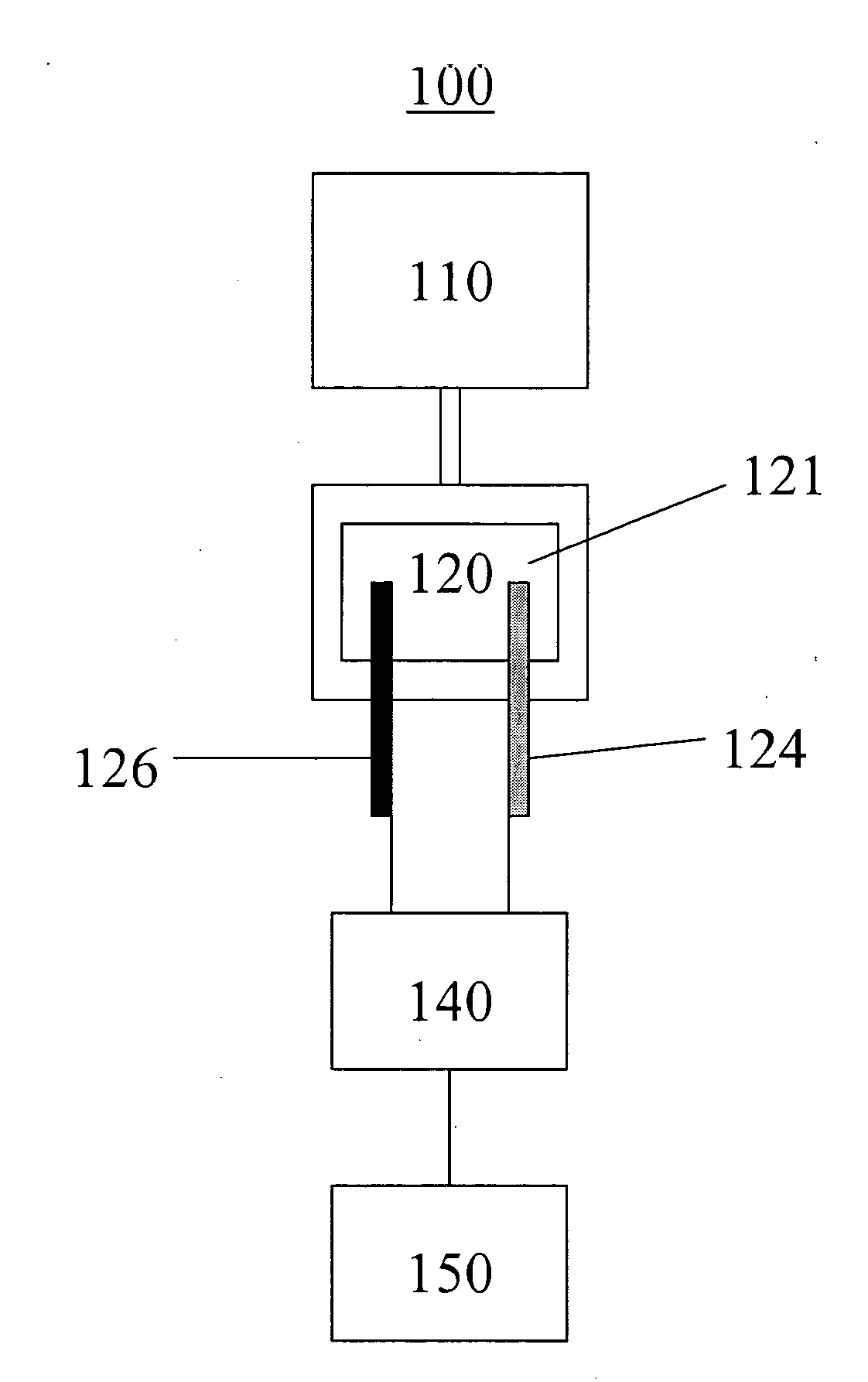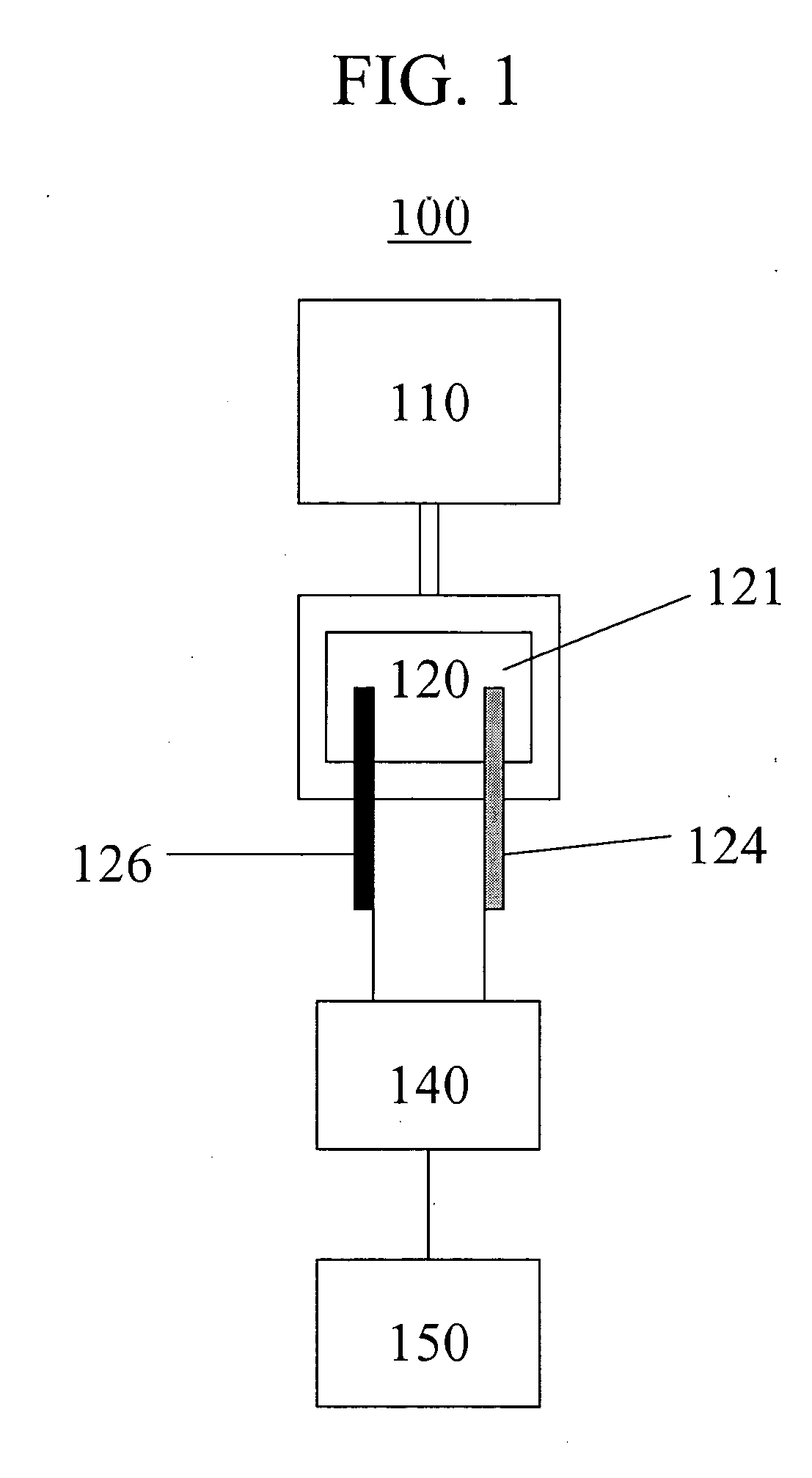Explosives detection sensor
a detection sensor and explosive technology, applied in the direction of liquid/fluent solid measurement, material electrochemical variables, instruments, etc., can solve the problems of affecting the widespread use of explosives, requiring relatively expensive instruments, and being difficult to detect,
- Summary
- Abstract
- Description
- Claims
- Application Information
AI Technical Summary
Problems solved by technology
Method used
Image
Examples
example 1
[0040] The following example demonstrates the ability of sensor 120 to detect the presence of explosive materials. A commercially available 40% nitroglycerin-nitrocellulose mixture of smokeless powder (BE) and Ammonium Nitrate / Fuel Oil (ANFO) were used as explosive materials. Urea and VOCs were used as interference compounds.
[0041] In the zero bias mode of operation, NMHCs, NO and CO yield a positive response of sensor 120, whereas NO2 yields a negative response. FIG. 4 is a plot of sensor response as a function of time for a sample comprising BE, ANFO, and urea that was rapidly heated to 300° C. in a furnace. As the sample decomposes, the vapors are carried into sensor 120 at 500 cc / min by air flowing through the sample tube that is in turn connected to a heated tube containing sensor 120. As seen in FIG. 4, both ANFO ((b) in FIG. 4) and BE ((c) in FIG. 4) yield negative responses, while urea ((c) in FIG. 4) yields a large positive response. The shape of the response curves obtain...
example 2
[0043] The following example demonstrates the ability of sensor 120 to distinguish between explosive vapors and other solvent vapors that could be present in the atmosphere. In this example, room air was pumped into the sensor 120 at a flow rate of 500 cc / min using a displacement pump. Next, 100 ml of either ethanol ((b) in FIG. 7) or heptane ((a) in FIG. 7) were then introduced near the inlet of the pump. The vapors of these organic compounds produced a large positive zero bias mode response in sensor 120, as shown in FIG. 7. In contrast to the positive response of sensor 120 to the organic vapors, explosive materials such as BE and ANFO generate a negative response in the zero bias mode, as seen in FIG. 4.
example 3
[0044] The following example demonstrates the ability sensor 120 and system 100 to detect trace quantities of explosive materials. The flow rate of the system was lowered to 50 cc / min ((a) in FIG. 8) and 10 cc / min ((b) in FIG. 8) in order to detect 2.4 μg and 3.6 μg of BE, respectively. The response of sensor 120 is shown in FIG. 8. As seen in FIG. 8, the sensitivity of sensor 120 may be increased by decreasing the flow rate of gases. The results suggest that the sensitivity of sensor 120 and system 100 increased to substantially less than microgram (μg) quantities of explosives by tuning the collection system or by using sample concentration techniques.
[0045] Sensor 120 is also compatible with most commercially available sample collection systems and can be used to replace detectors of currently available trace explosive detection systems. Moreover, sensor 120 is capable of detecting microgram quantities of explosive materials using a rudimentary collection system, such as a heate...
PUM
 Login to View More
Login to View More Abstract
Description
Claims
Application Information
 Login to View More
Login to View More - R&D
- Intellectual Property
- Life Sciences
- Materials
- Tech Scout
- Unparalleled Data Quality
- Higher Quality Content
- 60% Fewer Hallucinations
Browse by: Latest US Patents, China's latest patents, Technical Efficacy Thesaurus, Application Domain, Technology Topic, Popular Technical Reports.
© 2025 PatSnap. All rights reserved.Legal|Privacy policy|Modern Slavery Act Transparency Statement|Sitemap|About US| Contact US: help@patsnap.com



